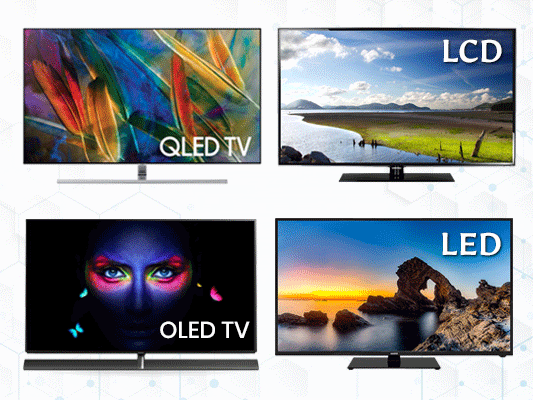VARIATIONS OF TV SCREENS: LCD, LED AND MORE

There was a time when we had only the bulky and cumbersome televisions. Things have completely changed now. At present, TVs come is a slimmer and lighter design, thanks to the advancement in technology. More importantly, the picture quality has massively improved comparatively. With an array of TVs come in different screen types like LCD, LED, etc in the market, it can get quite confusing when we approach a store to buy a TV. However, with a clear understanding of the features and qualities of the TV screen variants, you can comprehend the differences between them which will enable you to easily purchase a TV.
Through this article, we will explain the differences between the TV screens available in the current marketplace. Let's get started!
LCD Screen
You might know what LCD stands for. For those who don't, the elaborated form of LCD is Liquid crystal display. LCD TVs were the successors of the old CRT TVs and it was introduced at the start of 2000s. It was after the arrival of LCD TVs, the option of mount the TV on the wall became available. This screen technology uses the same liquid crystal display used in some laptops and computers. The LCD panels are accompanied by CCFL (Cold Cathode Fluorescent Lamps) which acts as the backlights since LCD don't have the ability to emit the light. LCD panels are comprised of two layers and the liquid crystals are placed on of those layers. What the liquid crystal does is, it blocks or allows the light and display the image accordingly when the electric current is passed through it. LCD TVs are slim and consume very less space. It can either be placed on the stand it comes with or hung on the wall as we said earlier. They are also capable of displaying high-resolution images from 480p up to 8K.
Key Features of LCD Screen
- Can display sharp images
- The images will be free from geometric distortion
- Can produce bright and colourful images
- Consumes very less electricity
- Produces very less heat
LED Screen
LED is similar to LCD since they use the same technology. However, in LED TVs, light-emitting diodes are placed as backlights unlike the CCFL in LCD screens. The LED which acts as the backlight is the main reason why LED TVs are slim because LEDs are smaller than CCFL. Another important feature of LED screens is that they can produce more light with less power making it energy efficient. This also makes the pictures more vivid on the LED screen. There are two further variations in LED. They are Edge-lit LEDs and Backlit or Full-array LEDs.
In the former, the LED lights are placed on the edges of the TV screen. These lights face the screen to illuminate it. Since the lights are around the perimeter of the screen, TVs with Edge-lit LEDs are normally really thin. On the other hand, in the latter, the lights are placed on the back of the TV. Apparently, the TV won't be as thin as Edge-lit but since the lights are spread on the back in every area, the TV produces brighter and clearer pictures.
Key Features LED Screen
- Brighter and sharper images when compared to LCD
- Offers better viewing angles
- Provides better contrast ratio
- They are energy-efficient
- Decen longevity
OLED Screen
Organic Light-emitting diode (OLED) is one of the cutting-edge technologies available at the moment. OLED TVs might cost a tad higher than LED or LCD but it'll give you the best visual experience. The pixel comprised in OLED features an organic material that glows voluntarily when the electric current is passed through them. The pixels are smart enough to glow only when there is current flow which means the light won't be scattered on the screen. The absence of backlight enables the TV to be thin and sometimes even as slim as a smartphone. OLED TVs even come in curved designs allowing the viewer to watch the TV in the best colour and contrast regardless of where they sit. OLED is also capable of tackling the blur in the motion videos. This means you can watch fast-paced videos in optimum clarity without any blur. Are you thinking why it's called 'Organic' light-emitting diode? Well, it's because the organic material mentioned above is made up of carbon and other components. Adding to all these, OLED supports 3D, 4K and Dolby content.
Key Features OLED Screen
- Enables the TV to be thinner, weightless and, flexible
- Unrivalled contrast ratio
- Capable of producing exceptional dark blacks and bright whites
- Offers large viewing angles
- Produces vivid colours even without the need of backlighting
QLED Screen
QLED TVs were developed by Samsung to compete with OLED technology. The illuminating method used in QLED is quite similar to LED and OLED screens. The 'Q' in the QLED stands for quantum dots which is the major element that distinguishes QLED from others. Placed on the backlight panel, these dots are tiny, powerful and, emit colours depending on its size. As per Samsung, the quantum dots can display billions of colours. Unlike OLED screens, the pixels in QLED isn't voluntarily illuminated or turned off according to the passing of electric current. Hence, the black level won't be as good as in OLEDs. However, the colours produced are bright, crisp and, punchy in QLED which gives it a better edge over OLEDs. Furthermore, the energy-efficiency and, brightness are slightly better than LED and OLED models.
Key Features QLED Screen
- Produces vibrant and accurate colours than OLED
- Performs consistently for a long period
- Amazing picture quality
- Better contrast ratio than LCD and LED
- Bigger screens but the lighter and thinner design
Micro LED Screen
The terms LCD, LED, OLED and QLED must be familiar to you. What about MicroLED? You might have heard about it or doesn't have a clue what that is. Samsung recently introduced it at CES 2020 but it's yet to be fully launched. It's predicted that MircroLED will be the game-changer in the tech industry with its ability to display brighter, sharper and vibrant pictures. Just like we have seen in OLED and QLED screens, MicroLED is also an emissive display. However, illumination isn't done by organic diodes or quantum dots, instead, it boasts microscopic indium gallium nitride LEDs that emit the light and help display immersive pictures. The viewing angles, energy efficiency and, black level are also stupendous in MicroLED screens. As per the reports, this is how a MicroLED screen's performance will be like. The bottom line is, it's said to be better than the models we currently have in the market. We can see for ourself once MicroLED TVs start getting rolled out.
Wrapping Up
With this much screen types, buying a Smart TV can get so confusing. We hope you now know the distinction between the screen types. Each screen type has its own benefits. For example, LCD is cheaper but the picture quality is not as good as LED, OLED, etc. Now if you have a fair budget for a TV you can, OLED or QLED, which is a tad costlier than LCD and LED but great in displaying immersive pictures, would be ideal options. Also, let's not forget that MircroLED is yet to come. It's also important to understand what your needs really are before you buy a TV else you'll be simply wasting your money. Now that you have a clear picture of the screen types, have a look at the array of TVs we offer. Place an order and receive it within 24 hours. If you have more doubts regarding buying a TV, then refer our Smart TV buying guide.
